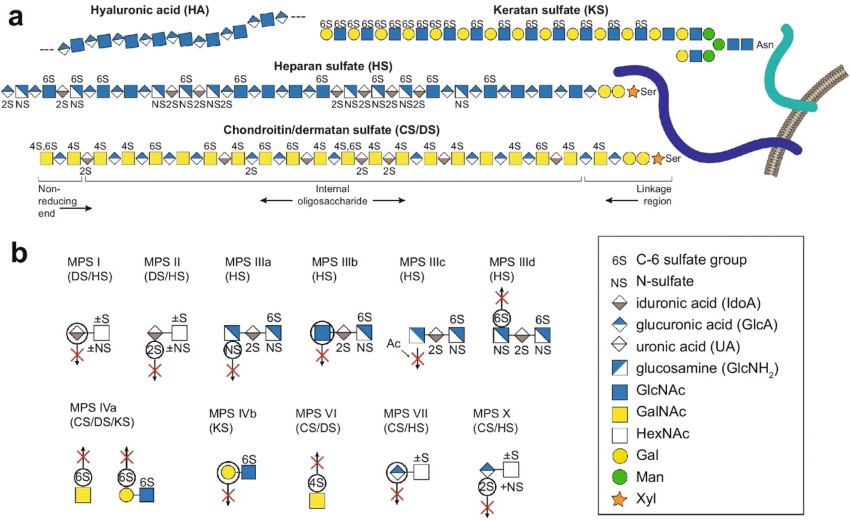Glycosaminoglycan (GAG) Analysis Service
Reliable Glycosaminoglycan (GAG) Analysis Service at Creative Biolabs
Glycoprotein molecules are often attached to different types of sugar groups (sugar chains), such as Sialic Acid, Monosaccharides, GAG, etc. GAGs are polysaccharides composed of repeating units that typically interact with proteins to form proteoglycan complexes that play vital roles in many cellular functions and physiological processes. Analysis of glycosaminoglycans in glycoproteins not only helps to improve the understanding of sugar molecules in organisms but also promotes progress in drug research and development, disease diagnosis, and treatment.
Creative Biolabs has strong Glycoprotein Analysis research teams, and we are dedicated to providing reliable GAG analysis services to clients around the world. It usually contains the following steps.
We extract glycoproteins from the sample to be analyzed (e.g., cell culture, tissue, etc.) and then treat the glycoprotein sample chemically or enzymatically in appropriate buffer conditions to release GAGs.
-
Enrichment and purification of GAGs
Before conducting GAG analysis, we use a variety of techniques to enrich and purify GAG, thereby effectively improving the purity and concentration of the sample for subsequent analysis and detection.
-
Ion exchange chromatography (IEX): We use the negative charge characteristics of GAGs to separate and enrich GAGs through different salt concentrations or pH gradients on IEX columns.
-
Gel filtration chromatography (GFC): We use GFC columns to separate and enrich GAGs according to their molecular size.
-
Affinity chromatography: We utilize the affinity between GAGs and specific ligands to enrich them through affinity chromatography columns.
-
High-performance liquid chromatography (HPLC): We achieve separation and enrichment of GAGs in HPLC systems using appropriate columns and solvent systems.
-
Ion mobility spectrometry (IMS): It is a localized gas phase method that enables rapid separation of GAGs and is easily coupled to MS.
-
GAGs analysis
-
Mass spectrometry (MS) is widely applied in the analysis of biological macromolecules, among which electrospray ionization (ESI) in negative ion mode is often used in the analysis of GAG. We combine ESI with a variety of separation techniques, such as LC and capillary electrophoresis (CE), to achieve qualitative and quantitative analysis of GAGs.
-
In addition, nuclear magnetic resonance (NMR) is also used to determine the GAG structure. We use single-dimensional or multi-dimensional NMR to perform GAG analysis and determine the composition of the sugar base.

Published data
In mucopolysaccharidosis (MPS) diseases, GAGs accumulate in various tissues and organs, damaging cells and organs. Studies have shown that specific non-reducing end GAG structures (GAG-NRE) have emerged as potential biomarkers for MPS. In this study, the authors developed a sample liquid chromatography-tandem mass spectrometry (LC-MS-MS) method to analyze MPS-associated GAG-NRE in urine samples from different patients. Firstly, the authors pre-treated the urine samples, then depolymerized GAGs using chondroitinase and heparinase, and labeled them with 2-aminobenzamide to improve the sensitivity of the analysis. Finally, the authors successfully identified multiple types of GAG-NRE through LC-MS-MS analysis, confirming their effectiveness as biomarkers for MPS.
 Fig.1 Schematic diagram of the structure of GAGs and biomarkers in MPS diseases.1
Fig.1 Schematic diagram of the structure of GAGs and biomarkers in MPS diseases.1
Advantages
-
Rich project experience: We have a professional team and technical experts who are proficient in GAG analysis methods and technologies and can complete analysis services accurately and reliably.
-
Efficient analysis process: We respond quickly to client needs, quickly complete sample analysis, and provide timely results and reports.
-
Multi-type sample analysis: We provide GAG analysis for multi-type samples. For example: biological tissue samples, cell culture supernatants, biological fluid samples, etc.
Application
-
Drug screening: GAG analysis helps evaluate the impact of new drugs on GAG metabolism and synthesis, thereby guiding the drug design and screening process.
-
Tissue engineering: GAGs play a vital role in tissue regeneration and repair, and the analysis of GAGs helps optimize the design and application of tissue engineering scaffolds.
-
Biological mechanism research: GAGs play an important role in cell signaling, tissue development, disease development, etc. The analysis of GAGs can help in-depth research on various biological processes.
Creative Biolabs has a professional analytical technology platform. We provide efficient GAG analysis and detection for a variety of biological samples to ensure the accuracy and reliability of results. Please contact us if you would like to acquire a high-quality GAG analysis service.
FAQ
Q1: What types of samples can be analyzed for GAGs?
A1: We analyze GAGs for a variety of sample types, including biological tissue samples (such as animal tissues), cell culture supernatants, biological fluid samples (such as serum, urine, etc.), and other relevant biological samples. These samples help clients gain insight into the role of GAGs in different biological processes and their applications in drug development and disease diagnosis.
Q2: How to analyze GAGs in biological samples?
A2: GAG analysis in biological samples usually involves several key steps: First, GAGs are extracted and released from the sample by appropriate chemical or enzymatic methods. Next, GAGs are enriched and purified using techniques such as ion exchange chromatography and gel filtration chromatography to increase the purity and concentration of the sample. Subsequently, GAGs are analyzed using analysis methods such as ESI-MS to reveal their structural and functional properties.
Q3: What is the cost of GAG analysis?
A3: The cost of GAG analysis varies depending on a variety of factors, including sample type, analytical complexity, and the specific techniques and methods required. The specific cost is usually evaluated in detail according to the requirements of the project. To ensure accuracy and reliability, it is recommended that you contact us directly to obtain personalized quotes and service information.
Customer Review
Efficient Service Response
“The Creative Biolabs team responded very quickly to my consultation, and the entire GAG analysis process went very smoothly. They completed the sample analysis and offered a detailed report in a short time. I was very satisfied with the results of the GAG analysis. The data was clear and reliable, which provided important support for my research.”
Rich Project Experience
“I found that Creative Biolabs has rich project experience in GAG analysis, and their professional capabilities are reassuring. They provided personalized GAG analysis solutions according to my special needs, allowing my project to proceed smoothly. After this pleasant cooperation, I decided to continue to cooperate with Creative Biolabs to carry out more related research in the future.”
Reference
-
Nilsson, Jonas, et al. "A glycomic workflow for LC-MS/MS analysis of urine glycosaminoglycan biomarkers in mucopolysaccharidoses." Glycoconjugate Journal 40.5 (2023): 523-540. Distributed under Open Access license CC BY 4.0, without modification.
For Research Use Only.
Related Services


 Fig.1 Schematic diagram of the structure of GAGs and biomarkers in MPS diseases.1
Fig.1 Schematic diagram of the structure of GAGs and biomarkers in MPS diseases.1



